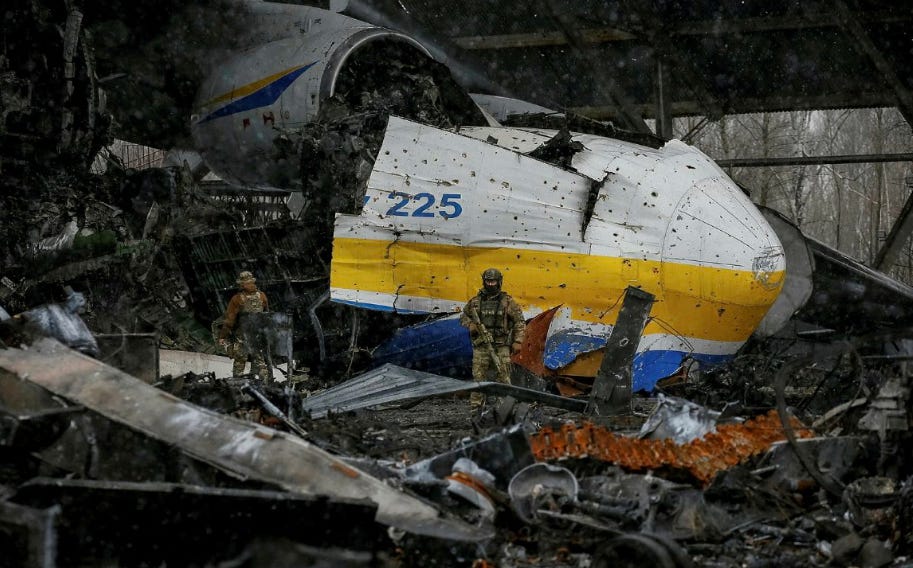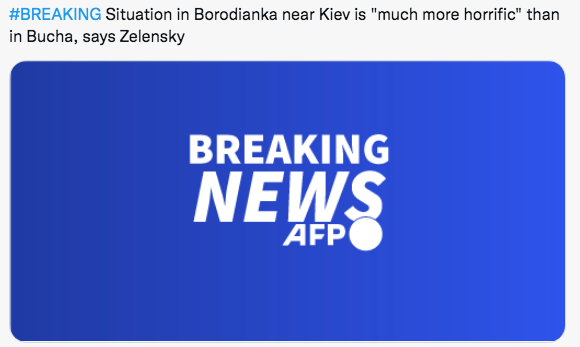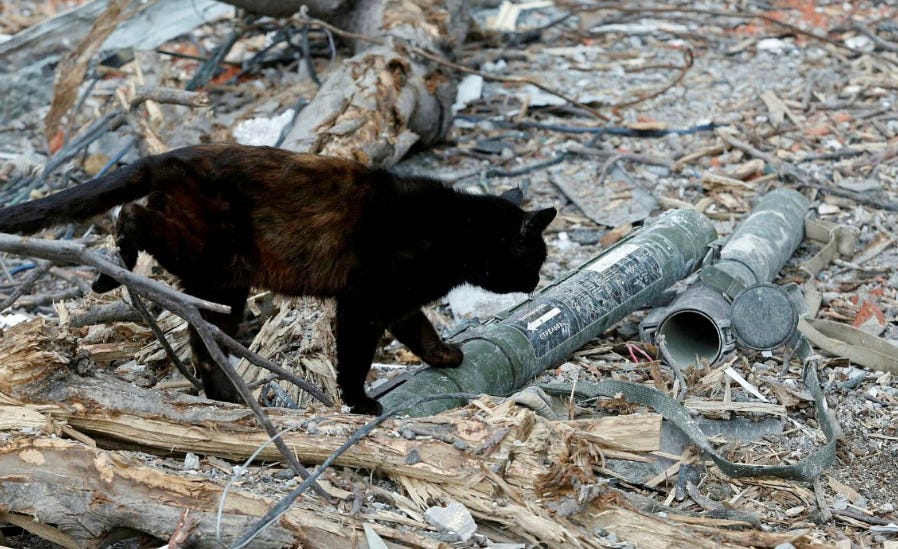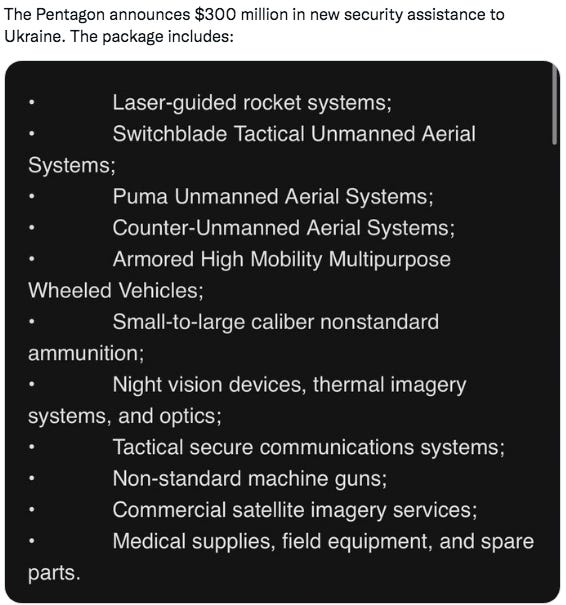How the West Weaponized Ukraine without triggering No Fly Zone
United States was sent “very massive” javelin since January 2022 (before war began), then sent tank-killing weapons to Ukrainian forces, but not fighter jets. It is equipping embattled Ukrainian troops with lightweight “kamikaze” attack drones, but not, at least in an obvious way, conducting an aggressive cyberwar to degrade Russia’s technological advantage.
The White House will commit no American or NATO planes to the skies above Ukraine, a move American officials fear could risk turning a regional war into a global conflagration, but it is providing Ukraine with missiles that could accomplish the same task of destroying Russian aircraft.
(photo: Gleb Garanich-Reuters)
Such is the tenuous balance the Biden administration has tried to maintain as it seeks to help Ukraine lock Russia in a quagmire without inciting a broader conflict with a nuclear-armed adversary or cutting off potential paths to de-escalation.
Navigating this path has led to a tangle of decisions, and sometimes tortured distinctions, when it comes to what kinds of assistance Washington should provide, even as the situation on the ground evolves, pictures of dead civilians circulate around the globe (especially about Bucha massacre) and President Volodymyr Zelensky of Ukraine pleads with Congress and President Biden to do more to help. And its still counting, because not yet really fully-reportage in Borodianka, in Mariupol, in Chernihiv, in Kherson.
The balancing act informs every aspect of American policy about the war, including the scope of the punishing sanctions imposed on the Russian economy, the granularity of the battlefield intelligence provided to Ukrainian troops, the killing power of the weapons systems coming over the border and whether, as Mr. Biden did this past week, to label President Vladimir V. Putin of Russia as a war criminal (the detail timeline update, here).
C.I.A., get help by (blessing in disguise) Head of BND (trapped in Kyiv since war began), are helping to ensure that crates of weapons are delivered into the hands of vetted Ukrainian military units, according to American officials. But as of now, Mr. Biden and his staff do not see the utility of an expansive covert effort to use the spy agency to ferry in arms as the United States did in Afghanistan against the Soviet Union during the 1980s. They have judged that such a campaign would be an unnecessary provocation, in part because NATO supply lines remain open and there is a functioning government in Kyiv.
The new war has forced a recalculation on other fronts. In one example, American officials have floated the idea of Turkey’s government providing Ukraine with the sophisticated S-400 antiaircraft system. It is the very system, made by Russia, that American officials punished Turkey — a NATO ally — for buying from Moscow several years ago. Now American diplomats see a way to pull Turkey away from its dance with Russia — and give the Ukrainians one of the most powerful, long-range antiaircraft systems in existence.
In the White House and the Pentagon, there have been active debates over which lethal weapons delivered to Ukraine meet the nuanced interpretations of what international law allows. American officials acknowledge that the judgments of government lawyers are valuable only up to a point, and that all that really matters is the judgment of one person: Mr. Putin.
The Russian president has his own complex calculus about when the military support to Ukraine from the United States and its NATO allies crosses the line. He has his own reasons not to escalate, given the combined power of the NATO members and his own military’s evident difficulties against Ukrainian forces. But he is also unlikely to accept defeat or a stalemate in Ukraine without further testing American resolve, despite explicit public warnings from Washington against the use of chemical, biological or even nuclear weapons.
Russia’s foreign minister, Sergey V. Lavrov, suggested that his country was prepared to raise the costs for any nation helping the Ukrainians in their struggle, declaring that all vehicles shuttling weapons into Ukraine would be considered legitimate military targets.
In contrast to a Javelin antitank missile that has only limited range on the battlefield, a MIG-29 could fly from Kyiv to Moscow in a matter of minutes, the generals said, a capability that the Kremlin might see as a direct threat.
The same day, the White House put forth another consideration: that to be delivered to Ukraine, the MIGs would have to take off from an air base in a NATO country, possibly inviting retaliation on NATO territory by the Russians.
Some American officials assert that as a matter of international law, the provision of weaponry and intelligence to the Ukrainian Army has made the United States a cobelligerent, an argument that some legal experts dispute. But while Mr. Putin has made threats about launching attacks to impede the military assistance, he has not yet acted to stop it by attacking bases in neighboring countries — NATO allies — where the equipment originates.
That could change, U.S. officials said, especially if Mr. Putin thinks he is cornered or in danger of losing. Even, since December 2021, actually U.S. had the idea to re-package or re-route Mi-17 helicopters originally intended for Afghanistan, to Ukraine. But this plan never ever executed by Pentagon.
White House, Pentagon, and even several ally admit, and have a proof Russia cornered in Ukraine. After a surprising setback the Russian General Staff, drawing on the traditions of Suvorov, Zhukov, etc. regroups, switches its line of effort, and focuses on closing the Slovianka pocket, trapping most of the Ukraine army.
(photo: Alexander Ermochenko-Reuters)
Cue words like “Kesselschlacht,” “deep maneuver,” “fire sack” etc. etc. They seize Ukraine’s Black Sea coast (up to Odessa) and Russia imposes a compromise, frozen armistice, in which Moscow walks away with some gains, though not overthrow of Ukrainian government. Deep Russian military competence has reasserted itself. But then there is (backup) Second Narrative. Putin and all high ranking in Kremlin, is hopping mad that he was lied to about what was doable, but neither he nor the generals really know the situation on the ground particularly well.
So they move broken units around, don’t really re-equip, rest, retrain, etc. but launch large scale attacks, while the Ukrainians chew on their logistics and, burning for revenge for civilian tortured and dead, attack ferociously. We saw in Bucha, even (BND have a proof) this atrocities in Bucha not only by Russia military but also Wagner Group (mercenaries).
And thus these offensives fail, some spectacularly. Ukrainian counterattacks, fed by Western arms supplies, push back, maybe to the line of contact, maybe into the Donbas (not Crimea). A Russian defeat becomes a debacle.
“It is a fine line the administration is still walking in every dimension of its support for Ukraine,” said Andrea Kendall-Taylor, a former senior intelligence official who specialized in Russia and is now at the Center for a New American Security. “They are trying to figure out how do you get right up to the line without crossing over in a way that would risk direct confrontation with Russia.”
Planes with pilots might be off the table, but armed drones are not. This past week, Mr. Biden announced that the United States would ship small Switchblade drones to Ukraine that could be used to blow up Russian armored vehicles. The single-use kamikaze drones have blade-like wings, do not require either a long runway or a complex satellite uplink, and can be controlled to divebomb tanks or troops, self-destructing when they explode. At long last information on switchblades, the 300s are shipped, a dozen UKR officers trained, and the latest 10 or so may be the powerful 600s sent to Ukraine.
Unlike the large Predator and Reaper drones used for decades in Iraq, Afghanistan, Pakistan and other countries, the portable drones pose no threat to Russian soil. Still, the White House authorized an initial shipment of only 100 of them to Ukraine — a small batch that could be intended to see how Mr. Putin reacts to their deployment on the Ukrainian front lines. Depending on the response, hundreds or thousands more could be on the way.
The proposal for Turkey to supply Ukraine with Russian-made S-400 antiaircraft systems would also test what Mr. Putin is willing to accept from NATO — and how far a NATO ally that in recent years often appeared to be building bridges to Moscow is willing to go in reiterating its commitment to the alliance and backing Ukraine.
The idea came up when Wendy R. Sherman, the deputy secretary of state, visited Turkey two weeks ago. Ms. Sherman declined to talk about her discussions.
A different senior American official said the United States knew the proposal would anger Mr. Putin. Ukraine already uses Turkish-made drones, but Turkey is worried that providing the antiaircraft systems could make the country a target of Russia’s wrath.
At the same time, the upside for Turkey could be substantial: It was suspended by the Trump administration from the F-35 fighter program — in which it was both a buyer and a manufacturer of parts for the advanced aircraft — after its purchase of the Russian S-400s. A deal to send the antiaircraft systems to Ukraine could open the door to re-entry into the F-35 program.
The State Department declined to comment. Officials at Turkiye’s embassy in Washington did not respond to messages seeking comment.
===
Thursday Night (April 7th), for first time ever, via Kremlin directly, Peskov (Putin spox) admit Russia losing “significant troops”. Not by Igor Konaschenko (Russia army forces spox).
The Ukraine war features tank columns and trenches, all features of Europe’s bloody conflicts of the past century. Thus far, there is little evidence that the United States — or Russia — is eager to escalate the conflict in the 21st century battleground of cyberspace. If Pentagon supplier really ready after “Special Order” since 3 weeks ago (*specific drone weapon, must be shipped 120-days), this is will be turning back by Ukraine to gain momentum on the skies, even without “no fly zone policy” by NATO.
What has been missing thus far is a large-scale Russian cyberattack that disables the power grid or communications systems inside Ukraine, which for the most part continue to operate despite the withering Russian barrage of artillery and airstrikes.
Until the invasion began, United States Cyber Command had a unit based in Kyiv that was helping the government fend off attacks. It is now operating from a nearby NATO country. There is fragmentary evidence that the United States and its allies worked to counter some of the attacks and to prevent others from being launched. But action seems to have been limited.
Inside the Biden administration, there is a view that Mr. Putin could be choosing his moment to launch a cyberattack against the American financial system in retaliation for the devastating financial sanctions imposed on his country by the United States and its allies. Unless and until that happens, the administration appears resolved not to launch a significant first strike and invite retaliation — especially given the risks to the U.S. economy and financial system if Russia were to target them.
Given Russia’s bloody history with Stinger missiles, American officials have been wary of advertising their use in Ukraine. This month, when Gen. Mark A. Milley, the chairman of the Joint Chiefs of Staff, visited an airfield near Ukraine’s border where Stingers were being unloaded, reporters traveling with him were barred from disclosing the whereabouts of the base.
Even after two senior American officials told the House Armed Services Committee during a public hearing that Stinger missiles were among the munitions being sent to Ukraine, spokespeople avoided using the S-word from the lecterns at the White House and Pentagon.







